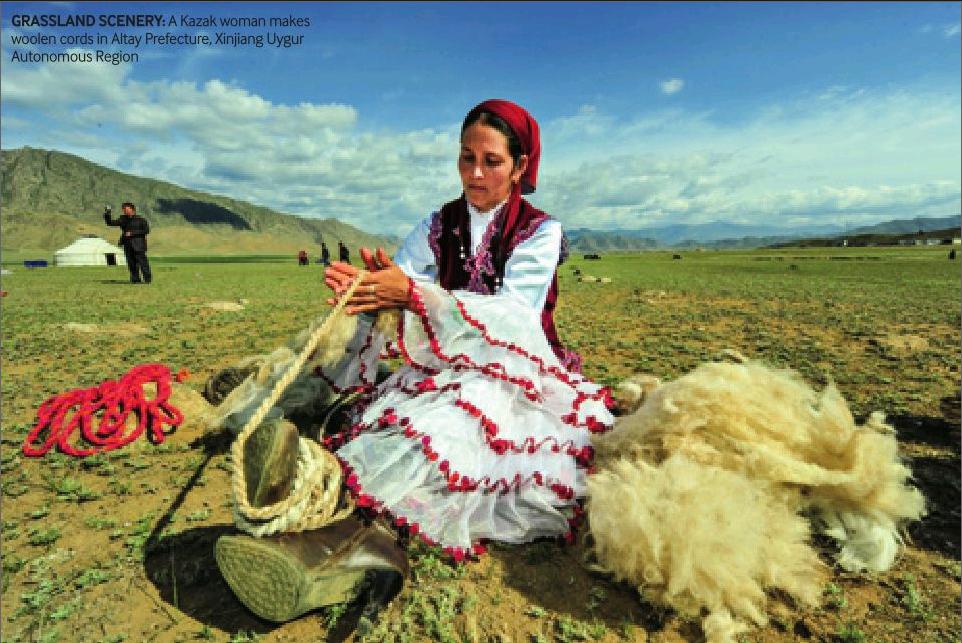A Shared Path
2014-07-28ByDengYaqing
By+Deng+Yaqing

Though trains have replaced camels as the primary mode of transport, and oil and gas have supplanted silk as the major commodity, the Silk Road has risen once again after Chinese President Xi Jinping first put forth the strategic conception of the Silk Road Economic Belt during his visit to four Central Asian countries in September 2013. The proposed belt traverses 18 countries in the Eurasian region and has a population of about 3 billion.
To foster a community sharing common interests and imparting mutual benefits, government officials, scholars and media representatives from 23 countries came from afar to Urumqi, capital of northwest Chinas Xinjiang Uygur Autonomous Region, to voice their opinions at the Silk Road Economic Belt International Seminar held on June 26-27.
“Turning the concept of the Silk Road Economic Belt into reality and allowing it to yield real benefits represents an arduous task. And the efforts and wisdom of all countries will be the recipe for success,” said Cai Mingzhao, Minister of the State Council Information Office at the opening ceremony.
“The Silk Road Economic Belt runs through Central Asia, South Asia and West Asia, and welds the Asia-Pacific and European economic circles. Its open to any countries and economic organizations that are willing to support it, build it and benefit from it,” said Zhong Shan, Vice Minister of Commerce.
The bridgehead
Located in the center of the Eurasian continent, Xinjiang has long acted as Chinas window toward Central Asia and Europe. Covering a sixth of Chinas territory and bordering eight countries, the region is destined to play a significant role in enhancing policy communication, traffic connectivity, smooth trade flow, currency circulation and people-to-people exchanges.
“Throughout the history of the route, the focus has been on economic and trade cooperation and cultural exchanges. And such activities will be intensified in the days and years to come,” Liu Huaqin, a researcher at the Chinese Academy of International Trade and Economic Cooperation, told Beijing Review.
Abundant in agricultural resources, Xinjiang is geographically, logistically, and economically well-situated to develop agricultural trade ties with countries along the belt.
“Every country in the region has its own comparative advantages and can complement each other,” said Buwajian Abula, a professor from the School of Economics and Business of Xinjiang Agricultural University, citing the fact that China primarily exports labor-intensive merchandise and imports land-intensive agricultural products.endprint
“Agricultural trade in the region concentrates on vegetables, grain, meat, milk, eggs and beverages,” Buwajian added. “But the absence of integrated safety standards allows some countries to impose restrictions on imports and pursue protectionist measures. Agricultural products often rot while awaiting customs processing. Introducing standardization can push enterprises to safeguard their brand reputation overseas and reduce the incidence of food safety issues,”said Buwajian.
Owing to its huge oil and gas reserves, Xinjiang has been designated as one of Chinas key energy bases. According to rough calculations, it accounts for 34 percent of the countrys total natural gas reserves, 30 percent of petroleum, and 40 percent of coal resources.
“In the future, a focus will be placed on the construction of oil and gas pipelines linking Central Asian countries with Russia and China,” said Zhang Xin, Director of the International Department of China National Petroleum Corp. (CNPC) He said that the company will start construction on the socalled “D line” on the Central Asia-China gas pipeline network with Tajikistan and strive to transport natural gas from Russia to China through the east part of the China-Russia natural gas pipeline by 2018.
“CNPC will expand Chinese-Central Asian energy cooperation at all stages from well drilling, oil extraction and pipeline construction to exploration and development, processing, technology service and training,”said Zhang Yaocang, Vice Chairman of the Board of CNPC.
Rich in oil and natural gas resources, Central Asian countries have been trying to exploit more export channels. Meanwhile, China, which used to rely largely on energy imports from the Middle East, hopes to diversify import sources to bolster energy security, said He Lunzhi, a professor from the Economic Research Institute of Xinjiang University.
Aside from agricultural and energy connections, many experts believe the Silk Road Economic Belt should be founded on a network of traffic corridors, with Xinjiang acting as a piv-otal port of transfer.
Zhang Chunxian, Party Secretary of Xinjiang Uygur Autonomous Region, stated that three corridors linking China with Europe as well as an integrated transportation network connecting China with Central, West and South Asia, Europe and Africa will be put in place.
More specifically, the north corridor starts from Altay and Tacheng in Xinjiang, passes through Russia and Kazakhstan and finally reaches Finland; the central corridor runs across Horgos and Alataw Pass in Xinjiang, passes Kazakhstan and Turkey and ends at Rotterdam, Holland; and the south corridor sets out from Kashgar in Xinjiang, goes through Iran and arrives at Gwadar, Pakistan.endprint
“Now, the most urgent task is to build Xinjiang into a comprehensive transportation hub, which is comprised of railways, expressways and air routes,” said Zhang Chunlin, Director of the Xinjiang Development and Reform Commission.
At the same time, Central Asian countries have also set about stepping up infrastructure building. At present, Kazakhstan is pressing on with the 2,787-km road transportation corridor linking West Europe with west China. Once completed, the distance between China and Western Europe will be shortened by a third.
Once Xinjiang is established as an important transportation center cementing Central Asia and China, it is foreseeable that China will eventually morph into a major channel for energy and minerals trade spanning the Atlantic and the Pacific oceans, said Pan Zhiping, an expert on Central Asian issues.
Economic interactions
“As an important section of the Silk Road Economic Belt, Central and West Asia will undoubtedly gather growth momentum through their participation,” said Alexander Lukin, Vice President of the Diplomatic Academy of the Ministry of Foreign Affairs of the Russian Federation.
Vladimir Petrovskiy, Chief Academic Researcher of the Institute of Far Eastern Studies under the Russian Academy of Sciences, said the building of the Silk Road Economic Belt initiative can incorporate with Eurasian Economic Union projects, and the two can develop in parallel until a free trade zone is built.
“More economic interactions along the belt will add to the volume of freight traffic to Russias railways in North Asia, the capacity of which has not yet been fully utilized,” said Liu.
“Tajikistan is completely landlocked, so the revival of the Silk Road means a lot to the country,” said Akbarali Sattorov, Chairman of Tajikistans Union of Journalists, listing three major tasks the Central Asian country faces—guaranteeing energy security, putting an end to the countrys transport and communication isolation, and ensuring substantial food supplies.
“The renewal of the Silk Road will certainly improve the livelihood of nearly every resident,” said Akbarali, referring to the fact that Xis visit to Central Asian countries last September brought contracts worth as much as $60 billion. To name a few, China and Uzbekistan signed contracts worth $15.5 billion related to petroleum and natural gas; China and Turkmenistan signed contracts worth $7.6 billion to extract natural gas; China and Kyrgyzstan signed contracts worth$7.5 billion to build natural gas pipelines; in Kazakhstan, the CNPC invested $5 billion to purchase an 8 percent share of an oil field in the Caspian Sea.endprint
